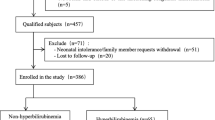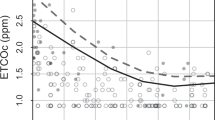Abstract
OBJECTIVE: The purpose of this study was to determine whether end-tidal carbon monoxide (CO) corrected for ambient CO (ETCOc), as a single measurement or in combination with serum total bilirubin (STB) measurements, can predict the development of hyperbilirubinemia during the first 7 days of life.
METHODS: From nine multinational clinical sites, 1370 neonates completed this cohort study from February 20, 1998 through February 22, 1999. Measurements of both ETCOc and STB were performed at 30±6 hours of life; STB also was measured at 96±12 hours and subsequently following a flow diagram based on a table of hours of age-specific STB. An infant was defined as hyperbilirubinemic if the hours of age-specific STB was greater than or equal to the 95th percentile as defined by the table at any time during the study.
RESULTS: A total of 120 (8.8%) of the enrolled infants became hyperbilirubinemic. Mean STB in breast-fed infants was 8.92±4.37 mg/dl at 96 hours versus 7.63±3.58 mg/dl in those fed formula only. The mean ETCOc at 30±6 hours for the total population was 1.48±0.49 ppm, whereas those of nonhyperbilirubinemic and hyperbilirubinemic infants were 1.45±0.47 and 1.81±0.59 ppm, respectively. Seventy-six percent (92 of 120) of hyperbilirubinemic infants had ETCOc greater than the population mean. An ETCOc greater than the population mean at 30±6 hours yielded a 13.0% positive predictive value (PPV) and a 95.8% negative predictive value (NPV) for STB ≥95th percentile. When infants with STB ≥95th percentile at <36 hours of age were excluded, the STB at 30±6 hours yielded a 16.7% PPV and a 98.1% NPV for STB >75th percentile. The combination of these two measurements at 30±6 hours (either ETCOc more than the population mean or STB >75th percentile) had a 6.4% PPV with a 99.0% NPV.
CONCLUSIONS: This prospective cohort study supports previous observations that measuring STB before discharge may provide some assistance in predicting an infant's risk for developing hyperbilirubinemia. The addition of an ETCOc measurement provides insight into the processes that contribute to the condition but does not materially improve the predictive ability of an hours of age-specific STB in this study population. The combination of STB and ETCOc as early as 30±6 hours may identify infants with increased bilirubin production (eg, hemolysis) or decreased elimination (conjugation defects) as well as infants who require early follow-up after discharge for jaundice or other clinical problems such as late anemia. Depending on the incidence of hyperbilirubinemia within an institution, the criteria for decision making should vary according to its unique population.
This is a preview of subscription content, access via your institution
Access options
Subscribe to this journal
Receive 12 print issues and online access
$259.00 per year
only $21.58 per issue
Buy this article
- Purchase on Springer Link
- Instant access to full article PDF
Prices may be subject to local taxes which are calculated during checkout
Similar content being viewed by others
References
Braveman P, Egerter S, Pearl M, Marchi K, Miller C Problems associated with early discharge of newborn infants. Early discharge of newborns and mothers: a critical review of the literature Pediatrics 1995 96 716–26
American Academy of Pediatrics, Provisional Committee for Quality Improvement and Subcommittee on Hyperbilirubinemia Practice parameter: management of hyperbilirubinemia in the healthy term newborn Pediatrics 1994 94 558–65 [published erratum appears in Pediatrics 1995;95:458–461]
Brown AK, Damus K, Kim MH, et al Factors relating to readmission of term and near-term neonates in the first two weeks of life. Early Discharge Survey Group of the Health Professional Advisory Board of the Greater New York Chapter of the March of Dimes J Perinat Med 1999 27 263–75
Heimler R, Shekawat P, Xy M, et al Morbidity of newborns (NB) after nursery discharge: relationship to early discharge (ED) Pediatrics 1996 98 (suppl) 576 (Abstract)
Lee KS, Perlman M, Ballantyne M, Elliot I, To T Association between duration of neonatal hospital stay and readmission rate J Pediatr 1995 127 758–66
Maisels MJ, Kring E Length of stay, jaundice, and hospital readmission Pediatrics 1998 101 995–8
Soskolne EI, Schumacher R, Fyock C, Young MI, Schork A The effect of early discharge and other factors on readmission rates of newborns Arch Pediatr Adolesc Med 1996 150 373–9
Johnson L, Bhutani VK Guidelines for management of the jaundiced term and near-term infant Clin Perinatol 1998 25 555–74 viii
Moyer VA, Ahn C, Sneed S Accuracy of clinical judgement in neonatal jaundice Arch Pediatr Adolesc Med 2000 154 391–4
Bhutani VK, Johnson L, Sivieri EM Predictive ability of a predischarge hour-specific serum bilirubin for subsequent significant hyperbilirubinemia in healthy term and near-term newborns Pediatrics 1999 103 6–14
Stevenson DK, Vreman HJ, Oh W, et al Bilirubin production in healthy term infants as measured by carbon monoxide in breath Clin Chem 1994 40 1934–9
Vreman HJ, Stevenson DK, Oh W, et al Semiportable electrochemical instrument for determining carbon monoxide in breath Clin Chem 1994 40 1927–33
Vreman, HJ, Baxter LM, Stone RT, Stevenson DK Evaluation of a fully automated end-tidal carbon monoxide instrument for breath analysis Clin Chem 1996 42 50–6
Vreman HJ, Wong RJ, Harmatz P, et al Validation of the Natus CO-Stat End Tidal Breath Analyzer in children and adults J Clin Monit Comput 1999 15 421–7
Vreman HJ, Verter J, Oh W, et al Interlaboratory variability of bilirubin measurements Clin Chem 1996 42 869–73
Hanley JA, McNeil BJ The meaning and use of the area under a receiver operating characteristic (ROC) curve Radiology 1982 143 29–36
DeLong ER, DeLong DM, Clarke-Pearson DL Comparing the areas under two or more correlated receiver operating characteristic curves: a nonparametic approach Biometrics 1988 44 837–45
Goddard MJ, Hinberg I Receiver operator characteristic (ROC) curves and non-normal data: an empirical study Stat Med 1990 9 325–37
Bosma PJ, Chowdhury JR, Bakker C, et al The genetic basis of the reduced expression of bilirubin UDP-glucuronosyltransferase 1 in Gilbert's syndrome N Engl J Med 1995 333 1171–5
Beutler E, Gelbart T, Demina A Racial variability in the UDP-glucuronosyltransferase 1 (UGT1A1) promoter: a balanced polymorphism for regulation of bilirubin metabolism? Proc Natl Acad Sci USA 1998 95 8170–4
Kaplan M, Renbaum P, Levy-Lahad E, et al Gilbert syndrome and glucose-6-phosphate dehydrogenase deficiency: a dose-dependent genetic interaction crucial to neonatal hyperbilirubinemia Proc Natl Acad Sci USA 1997 94 12128–32
Akaba K, Kimura T, Sasaki A, et al Neonatal hyperbilirubinemia and mutation of the bilirubin uridine diphosphate-glucuronosyltransferase gene: a common missense mutation among Japanese, Koreans and Chinese Biochem Mol Biol Int 1998 46 21–6
Valaes T, Petmezaki S, Henschke C, Drummond GS, Kappas A Control of jaundice in preterm newborns by an inhibitors of bilirubin production: studies with tin-mesoporphyrin Pediatrics 1994 93 1–11
Kappas A, Drummond GS, Henschke C, Valaes T Direct comparison of Sn-mesoporphyrin, an inhibitor of bilirubin production, and phototherapy in controlling hyperbilirubinemia in term and near-term newborns Pediatrics 1995 95 468–74
Martinez JC, Garcia HO, Otheguy LE, Drummond GS, Kappas A Control of severe hyperbilirubinemia in full-term newborns with the inhibitor of bilirubin production Sn-mesoporphyrin Pediatrics 1999 103 1–5
Stevenson DK, Rodgers PA, Vreman HJ The use of metalloporphyrins for the chemoprevention of neonatal jaundice Am J Dis Child 1989 143 353–6
Tada K, Chowdhury NR, Neufeld D, et al Long-term reduction of serum bilirubin levels in Gunn rats by retroviral gene transfer in vivo Liver Transplant Surg 1998 4 78–88
Brown WR, Boon WH Ethnic group differences in plasma bilirubin levels in full-term, healthy Singapore newborns Pediatrics 1965 36 745–51
Li AM, Yeung CY, Chang WK, Soo HN Epidemiological aspects of neonatal jaundice in Chinese infants Trop Geogr Med 1979 31 537–46
Fok TF, Lau SP, Hui CW Neonatal jaundice: its prevalence in Chinese babies and associating factors Aust Prediatr J 1986 22 215–9
Stevenson DK, Bartoletti AL, Ostrander CR, Johnson JD Pulmonary excretion of carbon monoxide in the human infant as an index of bilirubin production: IV. Effects of breast-feeding and caloric intake in the first postnatal week Pediatrics 1980 65 1170–2
Lundh B, Johansson MB, Mercke C, Cavallin-Stahl E Enhancement of heme catabolism by caloric restriction in man Scand J Clin Lab Invest 1972 30 421–7
American Academy of Pediatrics, Committee on Fetus and Newborn Hospital stay for healthy term newborns Pediatrics 1995 96 788–90
Kaplan M, Hammerman C, Feldman R, Brisk R Predischarge bilirubin screening in glucose-6-phospate dehydrogenase-deficient neonates Pediatrics 2000 105 533–7
Alpay F, Sarici SU, Tosuncuk HD, Serdar MA, Inanc N, Gokcay E The value of first-day bilirubin measurement in predicting the development of significant hyprebilirubinemia in healthy term newborns Pediatrics 2001 106 (2). URL: http://www.pediatrics.org/cgi/content/full/106/2/e16
Acknowledgements
We thank Ann Olthof, RN, and Petra A. Swidler, MD (Lucile Salter Packard Children's Hospital), Sue Bergant, RN (Rainbow Babies' and Children's Hospital), Elizabeth Kring, RN (William Beaumont Hospital), Dr Ka-Yin Wong (Queen Mary and Tsan Yuk Maternity Hospitals), Angelita Hensman, RN (Women and Infants Hospital), and Christine Dalin, RN (Pennsylvania Hospital). Advice on protocol decision and statistical analysis from Professor B. W. Brown is gratefully acknowledged.
Author information
Authors and Affiliations
Additional information
This study was supported by a grant from Natus Medical (San Carlos, CA) and the H. M. Lui Research Fund.
Rights and permissions
About this article
Cite this article
Stevenson, D., Fanaroff, A., Maisels, M. et al. Prediction of Hyperbilirubinemia in Near-Term and Term Infants. J Perinatol 21 (Suppl 1), S63–S72 (2001). https://doi.org/10.1038/sj.jp.7210638
Published:
Issue Date:
DOI: https://doi.org/10.1038/sj.jp.7210638
This article is cited by
-
Reference intervals for end-tidal carbon monoxide of preterm neonates
Journal of Perinatology (2022)
-
A novel G6PD deleterious variant identified in three families with severe glucose-6-phosphate dehydrogenase deficiency
BMC Medical Genetics (2020)
-
National Institute of Child Health and Human Development (NICHD) Conference on Kernicterus: A Population Perspective on Prevention of Kernicterus
Journal of Perinatology (2004)
-
End-tidal Breath Carbon Monoxide Measurements are Lower in Pregnant Women with Uterine Contractions
Journal of Perinatology (2004)



